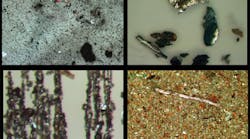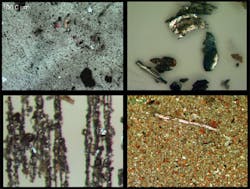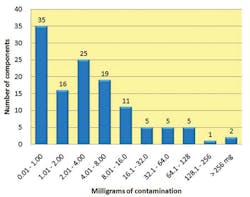Appeared in print as "Minimizing the impact of built-in contamination"
It is widely recognized that contamination creates problems in hydraulic systems. The explanation is straightforward — minimizing the gaps or clearances between moving parts improves efficiency and permits precise machine control. Particles compromise efficiency through abrasive wear and interfere with machine control when they become lodged in electrohydraulic valves.
Hydraulic equipment manufacturers have found that built-in contaminants introduced through the assembly of dirty components increase warranty costs. Three common strategies are employed by hydraulic equipment manufacturers to minimize the impact of built-in contamination:
1) Establish contamination limits for new components.
2) Verify that components comply with contamination limits.
3) Flush the assembled system to achieve roll-off cleanliness target.
Set contamination limits
Establishing the contamination limits for components, like most other engineering decisions, involves a cost/benefit analysis. Although it is obvious that a clean part is preferable to a dirty part, there is a cost associated with achieving a given level of cleanliness. Therefore, consider the contamination sensitivity and working pressure of a hydraulic system when establishing contamination limits.
Generally, contamination limits for components are specified in terms of the milligrams of contamination and the length (longest chord) of the largest particle. As shown in Table 1, the volume-to-area ratio of hydraulic components covers several orders of magnitude. (Area, in this case, only applies to wetted surfaces that are in direct contact with the hydraulic fluid.)
To account for differences in volume and wetted surface area, different units of measure are used to define the built-in contamination levels. Table 2 provides a list of contamination limits for new components expressed in common units of measure. For components that have a high volume-to-area ratio, mg/l is a common unit of measure. For components that have a low volume-to-area ratio, mass per unit weight or mass per unit area is more appropriate. The main reason for this is that the practical limit of detection in gravimetric contamination analysis is between 1 and 2 mg. This limit is not a function of accuracy of the analytical balance. It is the result of variation in the solvent and moisture absorption by the filter membrane used in gravimetric analysis.
A common mistake in establishing component cleanliness specifications is to express limits in terms of an ISO Contamination Code. This is understandable because ISO Codes are a well known shorthand for specifying hydraulic fluid cleanliness. However, Contamination Codes, as defined by ISO 4406, only apply to fluids. So specifying a maximum ISO 18/16/13 contamination code for a hose, tube, valve, cylinder, pump, reservoir etc. is incorrect. The above limit might be suitable as a roll-off cleanliness specification for an assembled vehicle, but to use it for components is problematic on several levels. Of particular concern is the fact that the ISO 4406 Contamination Code makes no distinction between 15, 150 or 1500 ∝m particles. Large particles are of great concern in new hydraulic components because they can cause severe damage the first time the system is powered up.
Choose the right method of removal
Built-in contamination may be extracted from hydraulic components through pressure rinsing, ultrasonic cleaning, agitation, and functional bench test methods. A light petroleum distillate, such as filtered mineral spirits, is the preferred extraction fluid. This is because it is an effective cleaner that does not promote rust or interact with the filter membrane used to quantify the contamination level. ISO 4405, for determining contamination by the gravimetric method, is the standard for quantifying the contamination level. In this test method, particles are separated from the extraction fluid through vacuum filtration. The filter medium is dried in a non-ventilating oven, and the weight change (in mg) is recorded. Usually, the length of the largest hard particle is also determined through microscopic inspection of the filter membrane.
Contamination starts at the beginning
The Fluid Power Institute recently evaluated the contamination level of more than 100 new hydraulic components. This data set included hoses, tubes, fittings, valves, cylinders, pumps, and reservoirs. As can be seen in the graph, the contamination level in several new components exceeded 256 mg. This gives contamination a head start in attacking the hydraulic system at the beginning of its life.
The process of manufacturing components produces different types of contamination. Cutting a hose to length produces rubber and metal particles, as shown in the first photo. Machining a valve manifold produces cutting chips, as shown in the second photo. Welding the end caps onto a hydraulic cylinder produces iron oxide, as shown in the third image. Finally, fabricating a steel reservoir produces welding spatter in the form of molten metal, as shown in the final image. In all cases, post-processing must occur to prepare components for use in a fluid power system.
The assembly and filling process also introduces particles into a hydraulic system. Therefore, the contamination level of new systems should be verified as they are undergoing functional tests on the assembly line. Portable online particle counters are the preferred instruments for checking the cleanliness level. On-line particle counters provide a rapid means of analysis and are not susceptible to the pitfalls of bottle sampling.
The roll-off cleanliness target for a hydraulic system should be based on contamination sensitivity and working pressure as shown in Table 3. In some equipment, the system can be cleaned by simply cycling the machine’s actuators. If the system incorporates components that do not completely discharge or return fluid to the reservoir, an auxiliary flushing cart may have to be used to achieve the desired cleanliness level.
Once a system is assembled, purified, and shipped, it should remain sealed to prevent contamination. Oil changes in the first 2000 hr of machine operation frequently do more harm than good. That is because new oils are not necessarily clean, and end users often lack the equipment required to filter fluid into the system.
Starting a machine with a clean hydraulic system is the first step in achieving long and reliable equipment life.
Paul Michael is a research chemist at the Milwaukee School of Engineering. He can be reached at (414) 277-2238 or by email at [email protected]. Brian Blazel is an undergraduate research assistant at MSOE. He can be reached at [email protected].






